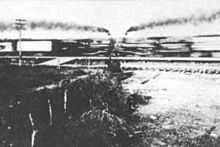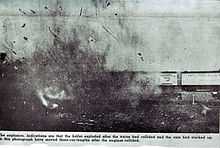Crush, Texas
Crush, Texas, was a temporary "city" established as a one-day publicity stunt in 1896. William George Crush, general passenger agent of the Missouri-Kansas-Texas Railroad (popularly known as the Katy), conceived the idea to demonstrate a train wreck as a spectacle.[1] No admission was charged, and train fares to the crash site were at the reduced rate of US$2 from any location in Texas. As a result about 40,000 people showed up on September 15, 1896, making the new town of Crush, Texas, temporarily the second-largest city in the state.
Unexpectedly the impact caused both engine boilers to explode. Debris, some pieces as large as half a drive-wheel, was blown hundreds of feet into the air.[2] Some of the debris came down among the spectators, killing two[3] or three[2] and injuring many more. Event photographer Jarvis "Joe" Deane lost one eye to a flying bolt.[4]
Preparations

Two wells were drilled at the site 3 miles (4.8 km) south of the town of West in McLennan County. Circus tents from Ringling Brothers were erected as well as a grandstand.[2] The train engines were painted bright green (engine #999) and bright red (engine #1001), both 4-4-0 American locomotives (two pilot axles, two drive axles, and nothing under the firebox). A special track was built alongside the Katy track so that there was no chance a runaway train could get onto the main line. Crush Texas was named after Mr. Crush who worked for the railroad and invented the Crash at Crush event. One of the descendants, Mark Crush, has made history available to Texas history scholars who study this event. The trains toured the state for months in advance, advertising the event.
Crash


The event had to be delayed for an hour because the crowd resisted being pressed back by the police to what was supposedly a safe distance. About 5:00 pm the two trains, pulling cars loaded with railroad ties, were rolled to the opposite ends of a 4-mile (6.4 km) track.[2] The engineers and crew opened the steam to a prearranged setting, rode for exactly 4 turns of the drive wheels, and jumped from the trains. Each train reached a speed of about 45 miles per hour (72 km/h) by the time they met near the anticipated spot.
The impact caused both engine boilers to explode. Debris, some large as half a drive-wheel, was blown hundreds of feet into the air.[2] Some of the debris came down among the spectators, killing two[5] or three[2] and injuring many more. Event photographer Jarvis "Joe" Deane lost one eye to a flying bolt.[6]
Aftermath
Crush was immediately fired from the Katy railroad. In light of a lack of negative publicity, however, he was rehired the next day.[7] The wreck was featured in an episode of the History Channel series Wild West Tech.
Scott Joplin's "Great Crush Collision March"
Ragtime composer Scott Joplin, who was performing in the region at the time and who possibly witnessed the event, wrote a piano piece called "Great Crush Collision March" to commemorate the crash; the composition was dedicated to the Missouri-Kansas-Texas Railway. It was copyrighted on October 15, 1896, a short month after the event.[8] The piece was notable because it included instructions in the score for how to replicate the sounds of the trains' collision through playing techniques, specific notes, and the use of dynamics.[9]
Further reading
- "The Crash at Crush" by Clay Swartz, pp 114-118, Cowboys & Indians magazine, August/September 2014. Five-page article with four large photographs (three of the same as in this article plus one crowd scene).
See also
References
- ↑ "Baylor University news story.". Baylor.edu. Retrieved 2013-05-21.
- ↑ 2.0 2.1 2.2 2.3 2.4 2.5 Allen Lee Hamilton. "Crash at Crush. Archived.." Handbook of Texas Online, University of Texas at Austin. Retrieved on 2007-04-15.
- ↑ Crash at Crush historical marker (accessed 2012-09-15).
- ↑ Perfesser Bill site. See also the Crash at Crush historical marker (accessed 2012-09-15).
- ↑ Crash at Crush historical marker (accessed 2012-09-15).
- ↑ Perfesser Bill site. See also the Crash at Crush historical marker (accessed 2012-09-15).
- ↑ Masterson, Vincent V. The Katy Railroad and the Last Frontier, (Google Books), University of Missouri Press, 1988, p. 272, (ISBN 0826206689). Retrieved 26 May 2007.
- ↑ Scott Joplin, "The Great Crush Collision March" sheet music (Temple, TX: John R. Fuller, 1896). See Bill Edwards, Rags and Pieces by Scott Joplin.
- ↑ "Scott Joplin's 'Great Crush Collision March' and the Memorialization of a Marketing Spectacle" post from the Baylor University Libraries Digital Collections blog". Retrieved April 19, 2012.
External links
- Ramos, Mary G. (1993). "The Crash at Crush". Texas Almanac. Texas State Historical Association.
- "Retired Katy Engineer Tells of Wreck at Crush". KATY Employes' Magazine. September 1950. Archived from the original on 2009-02-17.
- Krystek, Lee (2005). "The Great Texas Train Crash at Crush". The Museum of Unnatural Mystery.
- Sanders, J.R. (2010). "Crush's Locomotive Crash Was a Monster Smash". Wild West Magazine.
| |||||||||||||||||||||||||||||
Coordinates: 31°44′42″N 97°05′58″W / 31.745102°N 97.099571°W
